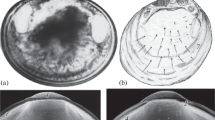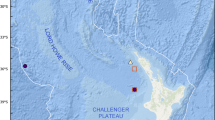Abstract
After investigation of the type specimens of 11 genera of ceriantharian larvae, it was concluded that the overwhelming majority of planktonic forms should be referred to the family Arachnactidae. Despite the fact that the presence of acontioids is traditionally considered as the only characteristic feature of this family, in most of the species acontioids develop at rather late ontogenetic stages. The importance of another feature, the presence or absence of p-rhabdoids, was considered. Members of suborder Penicillaria (Arachnactidae) typically have p-rhabdoids in the endoderm of alternate mesenteries and in acontioids. Members of suborder Spirularia (Cerianthidae and Botrucnidiferidae) have no p-rhabdoids and all cnidae in their mesenteries are restricted to the region of the mesenteric filament. In Arachnactidae the number of known larval forms significantly exceeds the number of benthic ones. The planktonic forms with developing and mature gonads were described in this family. The paedogenetic origin of Arachnactidae is discussed. It seems likely that, due to the uniformity and deficiency of definite morphological characteristics of the benthic members of the family Arachnactidae, only cnidom and type of the planktonic larva can be used for reliable taxonomical identification of the polyps.
Similar content being viewed by others
References
N. Annandale (1909) ArticleTitleA pelagic sea-anemone without tentacles Records of the Indian Museum 3 157–162
G. C. Bourne (1919) ArticleTitleObservations on Arachnactis albida M. Sars Quarterly Journal of Microscopical Science N.S. 64 27–65
A. Brito (1986) ArticleTitleDescripcion de Isarachnanthus cruzi, una nueva especie de cerianthario (Cnidaria: Anthozoa: Ceriantharia) de las Islas Canarias Vieraea 16 173–181
Carlgren, O., 1906. Die Actinien-Larven. In Nordisches Plankton. Zoologicher Teil 9. Kiel und Leipzig. Verlag von Lipsius & Tischer: 65–89.
O. Carlgren (1912a) ArticleTitleCeriantharia The Danish Ingolf-Expedition 1 1–78
O. Carlgren (1912b) ArticleTitleÜber Ceriantharien des Mittelmeers Mittheilungen aus der Zoologischen Station zu Neapel 20 356–394
O. Carlgren (1924a) ArticleTitlePapers from Dr. Th. Mortensen’s Pacific expedition 1914–16. XVI. Ceriantharia Videnskabelige Meddelelser fra Dansk Naturhistorisk Forening 75 169–195
O. Carlgren (1924b) ArticleTitleDie Larven der Ceriantharien, Zoantharien und Actiniarien der Deutschen Tiefsee-Expedition Deutsche Tiefsee-Expedition 1898–1899 19 341–476
O. Carlgren (1931) ArticleTitleOn some Ceriantharia Arkiv für Zoologi 23A IssueID2 1–10
P. Cerfontaine (1891a) ArticleTitleNotes préliminaires sur l’organisation et le développment de différentes formes d’Anthozoaires. IV. Sur un nouveau Cerianthe du golfe de Naples, Cerianthus oligopodus (n. sp.). Bulletin de l’Académie royale des sciences, des lettres et des beaux-arts de Belgique 21 IssueID3 32–39
P. Cerfontaine (1891b) ArticleTitleNotes preliminaires sur l’organization et le développment de differentes formes d’anthozoaires.Deuxième communication Bulletin de l’Académie royale des sciences, des lettres et des beaux-arts de Belgique 22 IssueID3 128–148
J. C. den Hartog (1977) ArticleTitleDescription of two new Ceriantharia from the Caribbean region, Pachycerianthus curacaoensis n. sp. and Arachnanthus nocturnus n. sp. with discussion of the cnidom and of the classification of the Ceriantharia Zoologische Mededelingen 51 211–242
C. Gravier (1904) ArticleTitleRecherches sur un Cérianthaire pélagique du Golfe de Californie (Dactilactis benedeni, n. sp.) Annales des Sciences Naturelles 20 253–294
C. Gravier (1920) ArticleTitleLarves d’Actiniaires provenant des campagnes scientifiques de S. A. S. le Prince Albert I de Monaco Résultats des Campagnes Scientifiques Accomplies sur son Yacht par Albert I Prince Souverain de Monaco 57 3–25
E. Leloup (1932) ArticleTitleCérianthaires de l’Océan Atlantic Bulletin du Musée Royal d’Histoire Naturelle de Belgique 8 1–19
E. Leloup (1942) ArticleTitleLarves de Cérianthaires appartenant a trois espèces nouvelles Bulletin du Musée Royal d’Histoire Naturelle de Belgique 18 1–16
E. Leloup (1954) ArticleTitleA propos d’Arachnactis albida M. Sars Report on the Scientific Results of the “Michael Sars” North Atlantic Deep-Sea Expedition 1910 5 1–6
E. Leloup (1964) ArticleTitleLarves de Cérianthaires Discovery Reports 33 251–307
E. Leloup (1968) ArticleTitleLarves de Cérianthaires du golfe de Guinée Bulletin de l’ Institute Royal des Sciences Naturelles de Belgique 44 IssueID7 1–22
J.P. McMurrich (1910) ArticleTitleThe Actinaria of the Siboga Expedition. I. Ceriantharia Siboga-Expéditie 15a 1–48
T. N. Molodtsova (2003) ArticleTitleOn Isarachnanthus from Central Atlantic and Caribbean region with notes on Isarachnactis lobiancoi (Carlgren, 1912) Zoologische Verhandelingen 344 249–255
T. N. Molodtsova V. V. Malakhov (1995) ArticleTitleOn the biology of Cerianthus lloydii Gosse (Anthozoa, Ceriantharia) from Kraternaya Bight, Kurile Islands Proceedings of the Zoological Institute St.-Petersburg 261 90–94
K.-G. Nyholm (1943) ArticleTitleZur Enlwicklung und Entwicklungsbiologie der Ceriantharien und Aktinien Zoologiska Bidrag fran Uppsala 22 87–248
Sars, M., 1846. Ueber Arachnactis albida, einen schwimmenden Polypen. In Fauna littoralis Norvegiae oder Beschreibung und Abbildungen neuer oder wenig bekannten Seethiere, nebst Beobachtungen ueber die Organisation, Lebensweise u. Entwickelung derselben 1. Christiania. Johann Dahl 28–30.
H. Schmidt (1974) ArticleTitleOn evolution in the Anthozoa Proceedings of the Second International Coral Reef Symposium 1 533–560
J.-I. Song (1986) ArticleTitleFirst report of a tube anemone, Cerianthus filiformis Carlgren, from Korean waters, including comparison of cnidae in adults and planulae Korean Journal of Systematic Zoology 2 79–97
H. Uchida (1979) ArticleTitleCerianthids (Anthozoa, Coelenterata) from Kii Region, Middle Japan Memoirs of the National Science Museum (Tokyo) 12 185–199
E. van Beneden (1897) ArticleTitleLes Anthozoaires de la “Plankton-Expedition Ergebnisse der Plankton-Expedition der Humboldt-Stiftung 2 k(e) 1–222
van Beneden, E., 1923. Travaux postumes d’Edouard Van Beneden sur les Cérianthaires. Archives de Biologie Volume Hors Série: 1–242.
E. Vanhöffen (1895) ArticleTitleUntersuchungen ueber Anatomie und Entwicklung von Arachanctis albida, M. Sars Bibliotheca Zoologica 20 IssueID1 1–14
Author information
Authors and Affiliations
Corresponding author
Rights and permissions
About this article
Cite this article
Molodtsova, T.N. On the taxonomy and presumable evolutionary pathways of planktonic larvae of Ceriantharia (Anthozoa, Cnidaria). Hydrobiologia 530, 261–266 (2004). https://doi.org/10.1007/s10750-004-2671-7
Issue Date:
DOI: https://doi.org/10.1007/s10750-004-2671-7




